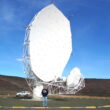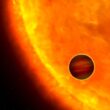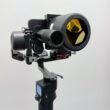The Astrophotonics Group is focused on designing, building, and testing advanced photonic systems with applications in radio astronomy, optical astronomy, and space science. Our group combines research expertise from people with a broad range of backgrounds including astronomy, physics and engineering. The group’s core technological capability is the long-distance transfer of stabilised optical-frequency and microwave-frequency signals across optical fibre networks and free-space laser links.
One of our primary projects is working with the international partners to develop and construct an optical fibre-based phase-synchronisation system for the Square Kilometre Array (SKA) telescope. This work includes laboratory-based experimental investigations, field deployments with existing telescopes, and engineering to construct the final hardware for the SKA telescope. We are also investigating the applicability of this technology for future facilities, such as the next-generation Very Large Array (ngVLA).
A second key research area is the development of ultra-precise laser timing links for the next-generation of pioneering space missions. These missions will revolutionize applications ranging from fundamental and applied science, such as measurements of fundamental constants and searches for dark matter, to geophysics, environmental monitoring, and high-speed communications. This project is conducted in partnership with the SmartSat Cooperative Research Centre, as well as international partners including the French national space agency, CNES.
Addition research projects currently include the development of new technologies for advanced optical astronomical interferometers; long-range atmospheric tests of optical phased arrays; and exploring novel manufacturing techniques for 3D printing optical components.
We are a growing group and are always looking for new research collaborators, industry partners, and eager students to help us continue our goal of having fun developing advanced photonic systems.



